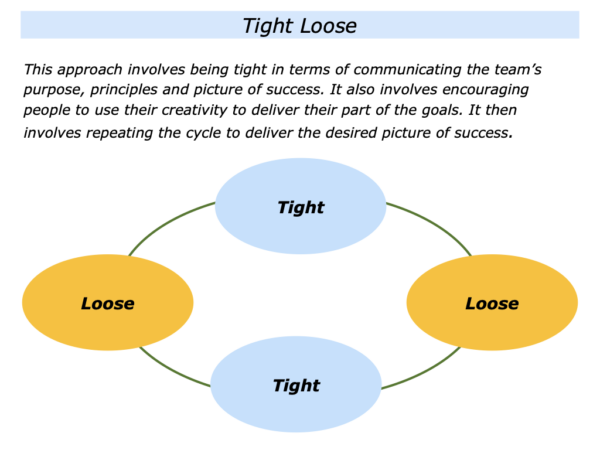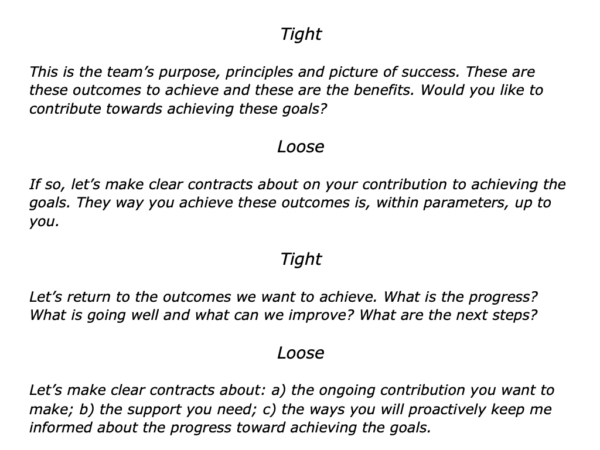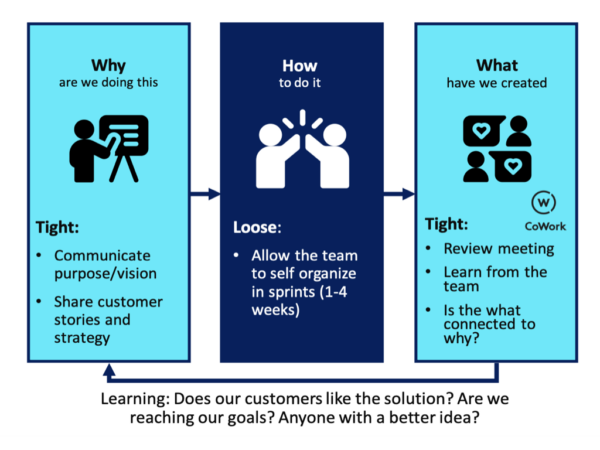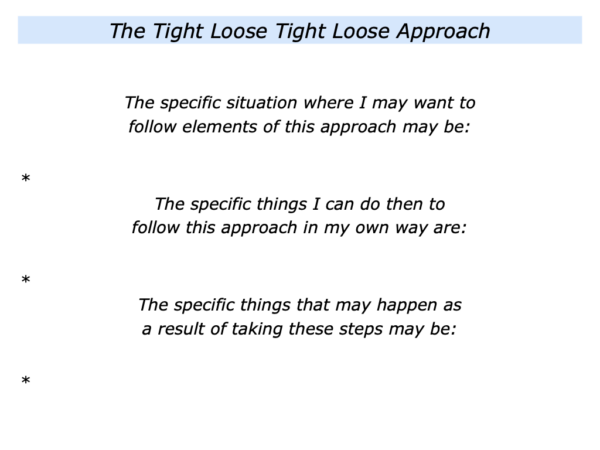
There are many leadership models for encouraging people to work towards achieving certain goals. Some of these models include elements of the tight and loose approach.
Rune Ulvnes, for example, developed what he called the Tight Loose Tight approach in 2009. Since then he has enabled people to apply the approach in many ways. We will look at his approach later in this piece. Before then, however, here is some context.
Some leadership styles follow the tight approach. This involves a command and control structure. It provides tight instructions on: a) what people should achieve; b) how they should achieve it; c) when they should achieve it.
Such an approach has advantages. It gives the impression of being in control and supervising people into doing good work. The downsides include people feeling they are micromanaged.
Some leadership styles incorporate the loose approach. This involves a more open and consensual approach to clarifying the goals. It also gives people freedom regarding how they achieve the aims.
This approach has advantages. It comes across as being more humanistic and involving. The downsides include lack of decisiveness and everybody expressing a view about everything.
Some leaders use a tight loose tight loose approach. This involves managing by outcomes. It calls for communicating a clear purpose, principles and picture of success. It then gives motivated people freedom, within parameters, to use their talents to achieve the goals.
Different leaders apply this approach in different ways. Some keep working through the tight loose tight loose cycle. This may involve them saying something along the following lines to their people.

Many leaders have adapted this approach to enable their teams to deliver the desired results. The following pages provide excerpts from articles written by Rune Ulvnes regarding his approach to using the model.
The Tight Loose Tight Approach
Purpose goals
My experience is that we must work towards what I have called purpose goals. These are fundamental if you work with Tight Loose Tight, a model that I developed about 10 years ago.
Purpose goals say something about what we as an organization want to achieve in the market – such as what effect our work should have. Examples of purpose goals may be:
We want to excite the audience on a deeper level;
We want to help our patients have a more worry-free everyday life;
We want employees not to get annoyed when they use the computer for normal activities.
The purpose of purpose goal is to engage the team in becoming innovative. For agile teams, it is easy to follow whether this happens through a glance at the result.
You as a leader should therefore use the opportunity to strengthen and clarify the purpose at every iteration so that the team understands the goals better.
Most teams that work with purpose goals can quickly find that one goal is better than another as the work progresses.
For example, the goal “We want to excite the audience on a deeper level” might not be understood, and the team might fail to deliver any reasonable results.
You should therefore seize the opportunity at any time to clarify the goal, for example “we want to give our audience two hours free of their worries while visiting our theater”.
I do think that the simplicity of the model is its strength. This is the core of TLT:
Tight: As a leader, you give a purpose or direction to your employee or team.
Loose: You trust your employee or team and allow them to self-organize.
Tight: You follow up on your employee or team from time to time for mutual learning.

Different leaders apply the tight loose themes in different ways. One approach involves reminding people of the outcomes to achieve. As mentioned earlier, this also calls for taking the following steps:
To communicate the purpose – the outcomes to achieve – and the principles people can follow to achieve picture of success;
To make clear contracts with people about the outcomes they will deliver and give them freedom – within parameters – to use their strengths to make their best contribution towards achieving the picture of success;
To again encourage people to keep focusing on the purpose – the outcomes to achieve – and enable them to do superb work that continues to contribute towards achieving the picture of success.
Leaders sometimes find this involves moving between the tight loose tight loose model in their own way. They then do their best to enable the team to achieve the picture of success.
Let’s return to your own work. Looking ahead, can you think of a situation where you may follow elements of this approach? How can you do this in your own way?
If you wish, try tackling the exercise on this theme. This invites you to complete the following sentences.







Leave a Reply